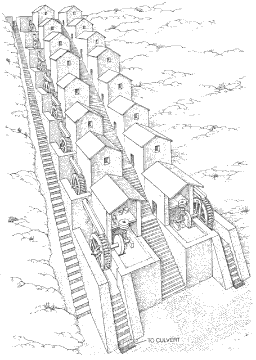The Roman Flour Mill at BarbegalThe Roman Flour Mill at Barbegal
IntroductionThe Roman flour mill at Barbegal is an example of something that, according to some experts,
never existed: a Roman water-powered factory. According to contemporary classicist A. Trevor
Hodge (p. 106), "Barbegal is significant because it calls into
question what may be termed the 'technology theory' of the decline and fall of the Roman Empire.
The theory maintains that the availability of cheap slave labor prevented the Romans from developing
alternative sources of power, without which large scale manufacturing is impossible." Twelve kilometers north of Arles, France, the aqueduct which fed water to the Barbegal mill
crosses a local road (see Illustration 1).
A colleague and I parked our rental car there and hiked 300 meters along the
ruins of a double line of arches (see Photo 1).
Soon we arrived at the fork where one aqueduct makes a 90 degree turn
(to provide drinking water to Roman community at Arelate,
modern-day Arles), but the second proceeds
straight, slicing through a solid rock outcrop (see Photo 2).
From the top of the outcrop, with a little imagination
and a drawing from Scientific American, it was possible to interpret the rubble below
(see Illustration 2). Flour MillThe concept was simple, but the application is impressive. Barbegal was an immense flour mill,
dating from the 4th century A.D. The power to drive the millstones came from 16
waterwheels, arranged in
two parallel rows of eight. Each row ran downhill so that the water dropped from one wheel to the next,
driving all eight in turn before running into a drain at the foot of the hill. 
Illustration 2. Overshot waterwheels are conjectured to have driven the 16 mills at Barbegal (drawing from Scientific American).
 | Click on the image for a larger version. |
Near the top of the ridge is a sign dedicated to the man who first investigated the site in 1940,
Fernand Benoit: "Thanks to his efforts we have a better understanding of the technological innovation of the
Roman Empire." Contemporary evidence of multiple mills during the Roman era is rare. While looking over the site, several other groups of intrepid travelers arrived at the site. Most
struggled to make sense of the rubble dotting the hillside. I lent my Scientific American illustration
to two of the groups. While one travel book alleges that the site is "well preserved," a healthy imagination
is still important (see Photos 3 and 4). Hodges has made an attempt to estimate the productivity of the 16 flour mills. Using conservative
estimates about the flow of water from the aqueduct, and assuming 50 percent downtime (to accommodate
interruptions for maintenance, breakdowns, late arriving grain shipments, and other interferences),
the mills could still produce enough flour to feed 12,500 individuals, the population of nearby Arelate
(present-day Arles) in the 4th century A.D. Other Roman MillsThere were at least two other multiple Roman mills, but neither was as ambitious as Barbegal.
Chemtou in western Tunisia, and the other mill were in
Israel on a dam on the Crocodile River near ancient Caesarea. According to
Hodges (p. 111): "Neither installation has been fully studied, but
together they remain the only known parallels to Barbegal." But he feels strongly that there are probably
other Roman mills that remain to be discovered. After all, Barbegal was undiscovered until the twentieth
century and it is located in a heavily populated area. ReferenceA. Trevor Hodge, "A Roman Factory," Scientific American (November, 1990), pp. 106-111. |
|
|